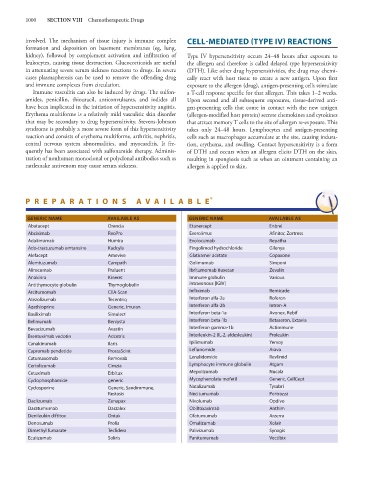Page 1014 - Basic _ Clinical Pharmacology ( PDFDrive )
P. 1014
1000 SECTION VIII Chemotherapeutic Drugs
involved. The mechanism of tissue injury is immune complex CELL-MEDIATED (TYPE IV) REACTIONS
formation and deposition on basement membranes (eg, lung,
kidney), followed by complement activation and infiltration of Type IV hypersensitivity occurs 24–48 hours after exposure to
leukocytes, causing tissue destruction. Glucocorticoids are useful the allergen and therefore is called delayed type hypersensitivity
in attenuating severe serum sickness reactions to drugs. In severe (DTH). Like other drug hypersensitivities, the drug may chemi-
cases plasmapheresis can be used to remove the offending drug cally react with host tissue to create a new antigen. Upon first
and immune complexes from circulation. exposure to the allergen (drug), antigen-presenting cells stimulate
Immune vasculitis can also be induced by drugs. The sulfon- a T-cell response specific for that allergen. This takes 1–2 weeks.
amides, penicillin, thiouracil, anticonvulsants, and iodides all Upon second and all subsequent exposures, tissue-derived anti-
have been implicated in the initiation of hypersensitivity angiitis. gen-presenting cells that come in contact with the new antigen
Erythema multiforme is a relatively mild vasculitic skin disorder (allergen-modified host protein) secrete chemokines and cytokines
that may be secondary to drug hypersensitivity. Stevens-Johnson that attract memory T cells to the site of allergen re-exposure. This
syndrome is probably a more severe form of this hypersensitivity takes only 24–48 hours. Lymphocytes and antigen-presenting
reaction and consists of erythema multiforme, arthritis, nephritis, cells such as macrophages accumulate at the site, causing indura-
central nervous system abnormalities, and myocarditis. It fre- tion, erythema, and swelling. Contact hypersensitivity is a form
quently has been associated with sulfonamide therapy. Adminis- of DTH and occurs when an allergen elicits DTH on the skin,
tration of nonhuman monoclonal or polyclonal antibodies such as resulting in spongiosis such as when an ointment containing an
rattlesnake antivenom may cause serum sickness. allergen is applied to skin.
PREP AR A TIONS A V AIL ABLE *
GENERIC NAME AVAILABLE AS GENERIC NAME AVAILABLE AS
Abatacept Orencia Etanercept Enbrel
Abciximab ReoPro Everolimus Afinitor, Zortress
Adalimumab Humira Evolocumab Repatha
Ado-trastuzumab emtansine Kadcyla Fingolimod hydrochloride Gilenya
Alefacept Amevive Glatiramer acetate Copaxone
Alemtuzumab Campath Golimumab Simponi
Alirocumab Praluent Ibritumomab tiuxetan Zevalin
Anakinra Kineret Immune globulin Various
Antithymocyte globulin Thymoglobulin intravenous [IGIV]
Arcitumomab CEA-Scan Infliximab Remicade
Atezolizumab Tecentriq Interferon alfa-2a Roferon
Azathioprine Generic, Imuran Interferon alfa-2b Intron-A
Basiliximab Simulect Interferon beta-1a Avonex, Rebif
Belimumab Benlysta Interferon beta-1b Betaseron, Extavia
Bevacizumab Avastin Interferon gamma-1b Actimmune
Brentuximab vedotin Adcetris Interleukin-2 (IL-2, aldesleukin) Proleukin
Canakinumab Ilaris Ipilimumab Yervoy
Capromab pendetide ProstaScint Leflunomide Arava
Catumaxomab Removab Lenalidomide Revlimid
Certolizumab Cimzia Lymphocyte immune globulin Atgam
Cetuximab Erbitux Mepolizumab Nucala
Cyclophosphamide generic Mycophenolate mofetil Generic, CellCept
Cyclosporine Generic, Sandimmune, Natalizumab Tysabri
Restasis Necitumumab Portrazza
Daclizumab Zenapax Nivolumab Opdivo
Daratumumab Darzalex Obiltoxaximab Anthim
Denileukin diftitox Ontak Ofatumumab Arzerra
Denosumab Prolia Omalizumab Xolair
Dimethyl fumarate Tecfidera Palivizumab Synagis
Eculizumab Soliris Panitumumab Vectibix

